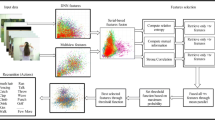Abstract
Based on the rapid development of big data, cloud computing, Internet of things and other technologies in recent years, intelligent hardware devices has been applied to all aspects of life. Under this background, some scholars have put forward relevant concepts such as “Smart Life”. In the field of mass sports life, through the development and application of science and technology, there has been new changes related to the application of neural network algorithm technology and intelligent hardware devices. Therefore, artificial intelligence wearable devices based on wearable technology came into being. This paper analyzes the application of this device in mass sports activities. Then, this paper describes the key research technologies of motion data processing based on neural network algorithm, including: depth frame differential convolution neural network structure, motion data extraction method, human motion signal processing algorithm, etc.; then it analyzes the action recognition and interaction system design based on Intelligent wearable devices. Finally, it analyzes the recognition results of human action system, the accuracy of human action recognition system and the factors that affect the performance of the recognition system. It is concluded that the artificial intelligent wearable devices designed in this paper can be well used in popular sports activities. Finally, it introduces the research on the evaluation strategy of popular sports activities based on artificial intelligence, and hopes that this equipment can help public sports activities. This paper studies the neural network algorithm and applies it to the design process of artificial intelligence wearable devices, which promotes the development of mass sports activity evaluation.






Similar content being viewed by others
Data availability
Data will be made available on request.
References
Chan M, Estève D, Fourniols JY et al (2012) Smart wearable systems: current status and future challenges. Artif Intell Med 56(3):137–156
Chao KH, Chen CY, Li CS (2013) A preliminary study of business intelligence in sports: a performance-salary model of player via artificial neural network. Int J Electron Bus Manag 11(1):13
Chen H, Liu H (2016) A remote electrocardiogram monitoring system with good swiftness and high reliablility. Comput Electr Eng 53:191–202
Finch CF, Gabbe BJ, Lloyd DG et al (2011) Towards a national sports safety strategy: addressing facilitators and barriers towards safety guideline uptake. Inj Prev 17(3):1–10
Huang X, Liu J, Zhu W et al (2019) The optimal threshold and vegetation index time series for retrieving crop phenology based on a modified dynamic threshold method. Remote Sensing 11(23):2725
Kotenko IV, Saenko I, Kushnerevich A (2017) Parallel big data processing system for security monitoring in Internet of things networks. J Wirel Mob Netw Ubiquitous Comput Dependable Appl 8(4):60–74
Kumar PM, Gandhi UD (2018) A novel three-tier Internet of things architecture with machine learning algorithm for early detection of heart diseases. Comput Electr Eng 65:222–235
Kumar J, Goomer R, Singh AK (2018) Long short term memory recurrent neural network (LSTM-RNN) based workload forecasting model for cloud datacenters. Procedia Comput Sci 125:676–682
Lezama J, Schweitzer P, Tisserand E et al (2015) An embedded system for AC series arc detection by inter-period correlations of current. Electr Power Syst Res 129:227–234
Li Z, Hou Q, Fu H et al (2015) Infrared small moving target detection algorithm based on joint spatio-temporal sparse recovery. Infrared Phys Technol 69:44–52
Pirbhulal S, Samuel OW, Wu W, Sangaiah AK, Li G (2019) A joint resource-aware and medical data security framework for wearable healthcare systems. Future Gener Comput Syst 95:382–391
Rajeev R, Samath JA, Karthikeyan NK (2019) An intelligent recurrent neural network with long short-term memory (LSTM) BASED batch normalization for medical image denoising. J Med Syst 43(8):1–10
Rao Z, Zeng C, Wu M et al (2018) Research on a handwritten character recognition algorithm based on an extended nonlinear kernel residual network. KSII Trans Internet Inf Syst (TIIS) 12(1):413–435
Sangaiah AK, Arumugam M, Bian GB (2020) An intelligent learning approach for improving ECG signal classification and arrhythmia analysis. Artif Intell Med 103:101788
Tang QY, Zhang CX (2013) Data processing system (DPS) software with experimental design, statistical analysis and data mining developed for use in entomological research. Insect Sci 20(2):254–260
Wang CH (2015) A market-oriented approach to accomplish product positioning and product recommendation for smart phones and wearable devices. Int J Prod Res 53(8):2542–2553
Funding
The authors have not disclosed any funding.
Author information
Authors and Affiliations
Corresponding author
Ethics declarations
Conflict of interest
The authors declare that they have no known competing financial interests or personal relationships that could have appeared to influence the work reported in this paper.
Ethical approval
This article does not contain any studies with human participants performed by any of the authors.
Additional information
Publisher's Note
Springer Nature remains neutral with regard to jurisdictional claims in published maps and institutional affiliations.
Rights and permissions
Springer Nature or its licensor (e.g. a society or other partner) holds exclusive rights to this article under a publishing agreement with the author(s) or other rightsholder(s); author self-archiving of the accepted manuscript version of this article is solely governed by the terms of such publishing agreement and applicable law.
About this article
Cite this article
Liang, J., He, Q. Application of artificial intelligence wearable devices based on neural network algorithm in mass sports activity evaluation. Soft Comput 27, 10177–10188 (2023). https://doi.org/10.1007/s00500-023-08249-y
Accepted:
Published:
Issue Date:
DOI: https://doi.org/10.1007/s00500-023-08249-y




